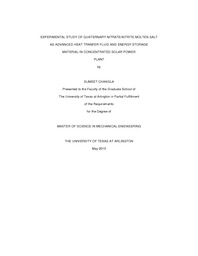
ATTENTION: The works hosted here are being migrated to a new repository that will consolidate resources, improve discoverability, and better show UTA's research impact on the global community. We will update authors as the migration progresses. Please see MavMatrix for more information.
Show simple item record
| dc.contributor.author | Changla, Sumeet | en_US |
| dc.date.accessioned | 2015-07-31T22:10:24Z | |
| dc.date.available | 2015-07-31T22:10:24Z | |
| dc.date.submitted | January 2015 | en_US |
| dc.identifier.other | DISS-13219 | en_US |
| dc.identifier.uri | http://hdl.handle.net/10106/25143 | |
| dc.description.abstract | Solar energy is used to produce electricity by two methods namely photovoltaic and concentrated solar power plant systems. Concentrated Solar power plants hold a distinct advantage over photovoltaic, which is that of energy storage. Energy can be stored in thermal energy storage system during day time and can be used to dispatch energy during peak demand and during raining or cloudy days to produce electricity. All concentrated solar power plants in operation use sensible heat storage method to store energy. Sensible heat storage system have been used in industry owing to ease of dispatch ability. Currently a binary mixture of NaNO₃ and KNO₃ (Solar Salt) is being used in industry owing to advantages such as, environmentally safe, low vapor pressure, relatively low cost and easy availability, low viscosity and compatibility with plant piping system. Heat is transferred to energy storage material through heat exchanger by high temperature fluid using forced convection. One of the disadvantages of this salt is low energy storage density, which in turn requires large storage tanks to store the material adding to the cost of the plant. Another drawback of using this mixture is its freezing point being too high. Temperature tends to drop at night and as a result salts tend to freeze. Along with freezing of the salt being an issue, other issue is the salt tends to expand on being heated to reuse again, which may lead to significant damage to Heat transfer fluid pipe system. Auxiliary equipment are required to keep the salt from freezing which increases the cost of the plant. To mitigate the thermodynamic losses because of the presence of the heat exchanger, it has been suggested to use HTF and TES as same substance, which would result in elimination of heat exchanger and reduce thermodynamic losses. From energy point of view, the efficiency of TES is considered high. A new Quaternary nitrate/nitrite mixture has been developed whose melting is 100°C. However, the major drawback of the salt to be used as TES/HTF is its poor thermos-physical properties such as lower specific heat capacity. Earlier there have been reports of substantial improvement in thermal properties of organic/inorganic salts on being doped with nanoparticles in minute concentration. Nanoparticle, on being doped in base salt tend to induce nanostructure, which due to its high surface area and high surface energy increase the heat transfer property. In this work, silica nanoparticle of various sizes are doped in the base eutectic salt to increase its specific heat capacity. After doping the base salt with silica nanoparticle it was observed, that there is anomalous enhancement in the specific heat capacity of the eutectic mixture. | en_US |
| dc.description.sponsorship | Shin, Donghyun | en_US |
| dc.language.iso | en | en_US |
| dc.publisher | Mechanical Engineering | en_US |
| dc.title | Experimental Study Of Quaternary Nitrate/nitrite Molten Salt As Advanced Heat Transfer Fluid and Energy Storage Material In Concentrated Solar Power Plant | en_US |
| dc.type | M.S. | en_US |
| dc.contributor.committeeChair | Shin, Donghyun | en_US |
| dc.degree.department | Mechanical Engineering | en_US |
| dc.degree.discipline | Mechanical Engineering | en_US |
| dc.degree.grantor | University of Texas at Arlington | en_US |
| dc.degree.level | masters | en_US |
| dc.degree.name | M.S. | en_US |
Files in this item
- Name:
- Changla_uta_2502M_13219.pdf
- Size:
- 2.488Mb
- Format:
- PDF
This item appears in the following Collection(s)
Show simple item record


